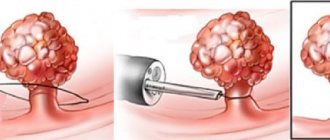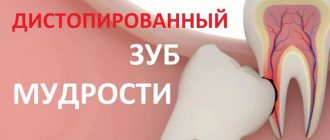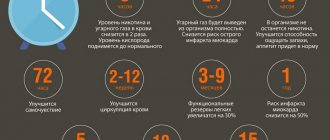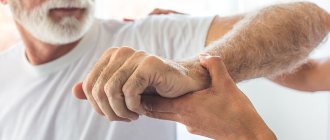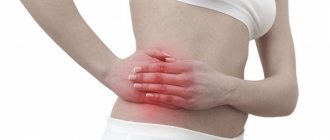- What causes appendicitis?
- How to prevent complications after appendicitis?
- Treatment of appendicitis Sutures after appendicitis
- What depends on the professionalism of the doctor?
- Diet after appendicitis
Appendicitis is a fairly common disease. If detected in time, it is quickly cured, but can only be eliminated surgically. At the same time, surgery to remove appendicitis is assessed by surgeons as the easiest. The development of appendicitis is justified by certain factors; it does not arise out of the blue.
| Prevention of appendicitis is not the least important in creating a healthy lifestyle. When the disease cannot be avoided, it makes sense to adjust your diet and daily routine. Rehabilitation after appendicitis does not require many restrictions, but in order to feel excellent, you must listen to your doctor’s recommendations. |
Recovery time
The main thing that influences the recovery period is how difficult the initial situation with the disease was. There are two options for the course of the disease: the development of a gangrenous process that turns into peritonitis, or simple inflammation of the appendix without its rupture. In the first case, hospital stay may last a month or even more. It is difficult to determine how many days it will be necessary to stay in the hospital after surgery, since the recovery of each individual organism cannot be predicted. In addition, with the development of purulent inflammation, it is impossible to do without a full-fledged abdominal operation, which significantly increases the period of observation by doctors. How many days do you have to wait after surgery to remove appendicitis using laparoscopy?
Recovery after this type of intervention is much faster. The maximum time a patient can spend in hospital is 14 days if there are no complications.
Diagnostics and preparation
As a rule, an appendectomy is necessary for a patient as an emergency, but first confirmation of the diagnosis is required. To do this, the doctor will examine the patient (palpation of the abdomen, ultrasound), study the medical history, collect complaints, and take blood and urine for express analysis. In most cases, diagnosis is not difficult, but patients require additional consultation with a gynecologist, since inflammation of the female genital organs (fallopian tubes, ovaries or uterus) has similar symptoms. To confirm the diagnosis, when the clinical picture of the disease is not clearly expressed, ultrasound, CT or abdominal x-ray are prescribed. After confirmation of the diagnosis, standard preparation for the operation begins, including consultation with an anesthesiologist and the choice of appendectomy technique. Also, to remove urine, the patient will be given a catheter and the stomach will be cleaned with an enema. In general, the preparatory stage takes no more than two hours.
Basic principles of surgical treatment and types of surgical access Free or paid treatment?
Rehabilitation after surgery
The minimum rehabilitation time after surgery is 2 months. But this is not the maximum period. The patient’s condition, his age, the presence of complications and concomitant diseases will also affect the speed of recovery. Already in the hospital itself, the process of postoperative rehabilitation begins. The first thing people pay attention to is the process of recovery from anesthesia.
To prevent vomit from entering the respiratory tract, the patient is turned on his healthy side.
Antibiotics and painkillers are also prescribed. To restore blood lost during the operation, IVs with saline solution may be prescribed. While patients are in the hospital, they are checked daily for: • Body temperature; • Arterial pressure; • Urination and defecation in order to control their recovery; • Condition of the wound and sutures; • Are there any development of postoperative complications. In the future, the patient is usually sent to a sanatorium and stays there for at least 21 days under the close supervision of a therapist and gastroenterologist. The main procedures for healing and bringing the body back to normal are: physiotherapy and diet. We'll talk about the latter in the next paragraph. Physiotherapy includes the main course - mud therapy with silt sulfide mud. There are many regions in Russia where they use it, but most often they go to Kislovodsk, Essentuki and Pyatigorsk to recover. These cities are famous as gastro-resorts and are loved by tourists not only from our country, but also from all over the world. In the Caucasus, rehabilitation with the mud of Lake Tambukan is an integral part of such treatment. are used to carry out a course of procedures .
The methods of their use are different, but most often they are applied to the stomach, insulated and give the applicators the opportunity to heal the desired area of the body. Such medical products are also sold in pharmacies with or without a prescription, but with the consultation of a doctor.
Laparoscopic appendectomy
Recently, with the development of technical capabilities in medicine, minimally invasive techniques, also used in the surgery of abdominal diseases, are becoming increasingly popular. Laparoscopic appendectomy is a worthy alternative to classical surgery, but for a number of reasons it cannot be performed on every patient.
Laparoscopic removal of the appendix is considered a more gentle method of treatment, which has a number of advantages:
- Low morbidity compared to abdominal surgery;
- Possibility of local anesthesia in most patients;
- Shorter recovery period;
- The best result for severe diseases of internal organs, diabetes, obesity, etc.;
- Good cosmetic effect;
- Minimum complications.
However, laparoscopic appendectomy also has some disadvantages. For example, an operation requires the availability of appropriate expensive equipment and a trained surgeon at any time of the day, because the patient can be taken to the hospital at night. Laparoscopy does not allow a detailed examination of the entire volume of the abdominal cavity, adequate sanitation and removal of exudate in common forms of the inflammatory process. In severe cases, with peritonitis, it is impractical and even dangerous.
Through many years of discussions, doctors determined the indications and contraindications for laparoscopic removal of the appendix.
The following are considered indications:
- Doubts about the diagnosis requiring laparoscopy for diagnostic purposes. For example, in a woman with pain in the right iliac fossa, after several hours of observation, the diagnosis of appendicitis cannot be confirmed. The surgeon goes for laparoscopy and discovers inflammation of the uterine appendages, which can spread to the appendix, or it is already inflamed, in which case it is quite logical to remove it laparoscopically. The child may be diagnosed with catarrhal appendicitis, and the appendix is removed during laparoscopy. These operations are performed in the absence of contraindications (purulent process, peritonitis), in which, after laparoscopy, open abdominal surgery is performed.
- Severe concomitant pathology (severe obesity, diabetes mellitus, heart failure), in which major surgical trauma is undesirable, the risk of infectious complications is high, and abdominal surgery is inevitably accompanied by large incisions (in obese patients).
- The patient’s desire to perform the operation laparoscopically (of course, if this does not conflict with safety).
- Laparoscopic surgery for gynecological pathology, when in case of adhesions, purulent inflammation of the pelvic organs, leaving even an unchanged appendix is impractical and is fraught with secondary appendicitis.
If there are no risks, the patient’s condition is stable, and the inflammation has not spread beyond the appendix, then laparoscopic appendectomy can be considered the method of choice.
Contraindications to minimally invasive treatment:
- More than a day from the onset of the disease, when the likelihood of complications is high (perforation of the appendix, abscess).
- Peritonitis and the transition of inflammation to the cecum.
- Contraindications for a number of other diseases - myocardial infarction, decompensated heart failure, bronchopulmonary pathology, etc.
In order for laparoscopic appendectomy to be a safe and effective treatment procedure, the surgeon will always weigh the pros and cons, and in the absence of contraindications to the procedure, it will be a low-traumatic treatment method with minimal risk of complications and a short postoperative period.
The course of laparoscopic appendectomy includes:
A small incision is made in the umbilical area through which carbon dioxide is injected into the abdomen for a good view. The laparoscope is also inserted through the same hole. The surgeon examines the abdomen from the inside, and if doubts arise about the safety of further manipulations, he proceeds to open surgery.- Instruments are inserted through incisions in the pubic area and right hypochondrium, with the help of which the appendix is captured, the vessels are ligated, the mesentery is cut off, then the appendix is cut and removed from the abdomen.
- Inspection and sanitation of the abdominal cavity, drainage if necessary, suturing the instrument insertion sites.
Laparoscopic surgery for appendicitis lasts up to one and a half hours, and the postoperative period takes only 3-4 days. Scars after such an intervention are barely noticeable, and after some time has passed for final healing, they can be difficult to find.
The suture after open surgery is removed after 7-10 days. A scar will remain at the site of the incision, which will thicken and fade over time. The scar formation process takes several weeks.
The cosmetic effect is largely determined by the efforts and skill of the surgeon. If the doctor treats the wound suturing conscientiously, the scar will be almost invisible. If complications develop, if it is necessary to increase the length of the incision, the surgeon will be forced to sacrifice the cosmetic side of the issue in favor of preserving the health and life of the patient.
Postoperative diet
The diet after appendicitis must be followed for at least 14 days. Eating is completely avoided the day before and the day after surgery. From liquids you can drink water or kefir 0% fat. All patients who are hospitalized are prescribed a fractional diet. You can eat 5-6 times a day, the portion size should not be large. It is better to choose products that will not cause a feeling of heaviness and bloating. What can be consumed:
- Porridge with water;
— Liquid potato, carrot or zucchini puree; - Rice broth; — Kefir or yogurt with 0% fat content; - Boiled and pureed chicken meat; - Chicken bouillon; - Kissel. After 3-4 days, it is recommended to add black bread with bran and baked apples. You can start eating puree soups, boiled meat and fish. Gradually, the list of permitted products is expanding and returning to the pre-operative one. What should not be consumed at all:
- Large amounts of salt; — Hot herbs and spices; — Peas, beans and other legumes; — Smoked meats; - Bakery products. All these products can irritate the gastric mucosa and can lead to increased gas formation.
Characteristics of permitted and contraindicated food products
After discharge from the hospital, the temptation to eat something tasty increases and an appetite appears. But for at least another 3 months there are dietary restrictions and foods that cannot be eaten. We provide a brief overview of nutritionists' recommendations for feeding patients at home.
Meatballs are prepared from lean minced meat and fish
Recommended:
- dishes from lean fish, chicken, beef, prepared only by boiling or steaming;
- soups can be prepared with water or low-fat meat broth with cereals (oatmeal, buckwheat, rice) and a mixture of eggs and cream; add a teaspoon of butter per serving;
- from the second week you can add minced meat and meatballs to soups;
- after appendicitis, you need to eat only wheat bread dried to the state of crackers, no more than 100 g per day;
- within a month, it is recommended to prepare soufflés, steamed cutlets, and meatballs from meat and poultry; from the second month, meat in pieces is allowed;
- It is better to make minced fish from low-fat fish (cod, blue whiting, hake, pike, pollock), then soufflé, quenelles, and steamed cutlets;
- In the second week, porridge is still given in semi-liquid form, butter and milk are added;
- Pumpkin, potato, zucchini, carrot purees, with the addition of beets, are widely recommended; cream, butter and milk are used;
- for children you can use ready-made vegetable food;
- daily consumption of one soft-boiled egg or in a steam omelet is recommended;
- cottage cheese is ground with milk or cream;
- apples are baked, from the second month you can eat fresh;
- Kissel, compote or jelly are made from non-acidic berries;
- honey and sugar together should not exceed 50 g per day for an adult;
- butter is added little by little to porridges and purees;
- Brew tea weakly; it is recommended to combine it with milk or cream, berry juices, herbs; rosehip decoction remains useful for drinking at all times.
[node:field_field_doprekl2]
As for fruits and sweets, at the end of the month you are allowed to eat dried fruits (dried apricots, prunes, figs, dates), citrus fruits (oranges and tangerines), peaches, strawberries, raspberries, marshmallows. You should be careful with honey and bananas due to their individual potential to cause constipation.
It is important to listen to the advice of experts
Over the next six months, the patient will have to get used to refusal:
- from fatty meat, sausages, smoked meat products;
- lard and margarine;
- mayonnaise, seasonings and hot sauces, ketchup, vinegar;
- porridge from beans, peas, beans, lentils;
- soups and salads with cabbage (including borscht);
- tomatoes;
- salted and smoked fish;
- canned food;
- fried foods;
- pancakes, pancakes;
- mushroom products (fresh, salted);
- onions, garlic;
- alcoholic beverages, beer, carbonated water, strong coffee and tea;
- full-fat cottage cheese and sour cream, condensed milk;
- pasta, dumplings, dumplings;
- chocolate, jam, cakes, sweets;
- sweet fruits (grapes, persimmons, pomegranates, nectarines, watermelon);
- ice cream
In the first two weeks it is better to limit salt. From the listed products you can create a delicious menu. The disadvantage is the reduced calorie content. This is useful for overweight people, but thin people will have to eat more often.
Allowed physical activity
The first movements after the operation can be made only after 8 hours. You can fully start walking only three days after the removal surgery. Lying down for a long time is strictly prohibited. Even in the hospital, an exercise therapy complex is prescribed together with a rehabilitation doctor. For the first 1.5-2 months, all physical activity should be limited exclusively to walks and exercises prescribed by a specialist. It is necessary to completely avoid carrying heavy bags and objects. Many patients are concerned about the question: how long after surgery can they resume sexual activity? It is not recommended to rush in any case. First of all, the stitches must heal. But in addition to the external ones, there are also internal ones, which take a little longer to overgrow. Their rupture can lead to the formation of hernias. If the course of appendicitis is favorable, sexual activity is resumed after 10-14 days.
Reviews and results
Postoperative nutrition has many restrictions, especially the first 2 weeks. However, then the diet can be diversified by introducing new dishes of stewed vegetables and soups with the addition of vegetables. Reviews from patients indicate that this type of nutrition has a beneficial effect on the gastrointestinal tract, and a gradual expansion of the diet and volume of food prepares for normal nutrition without discomfort in the intestines.
- “... I ended up in the department with appendicitis. Recovery was easy because the removal was through a small incision. On the second day I was already sitting up and walking around the ward a little. The food in the hospital was bad (dietary, of course), but from the third day there was no longer enough cottage cheese and I wanted fish, so they brought it all from home, as well as vegetable purees for normal bowel function. 1.5 months have already passed, I have fully recovered, but I continue to monitor my diet and do not eat fried, smoked or spicy foods. My wife boils or bakes everything. A healthy diet and you need to stick to it constantly, increasing the amount of fish, chicken and cottage cheese”;
- “... I had this food after my appendectomy. The condition was serious, so for a long time I ate everything pureed and slimy. I also started having problems with stool. So it turns out to be a vicious circle - you can’t eat vegetables, you can’t use laxatives, and juices and kefir don’t help. They brought baby vegetable food and well-ground boiled beets from home. When I started moving more, everything got better. Well, at home it became generally easier. By this time I switched to steam cutlets, meatballs and various soups”;
- “... With chronic appendicitis, you have to constantly adhere to a diet. I even regret that I didn’t have the operation earlier, but now every year it gets worse and I don’t want to anymore. Errors in diet, as well as intestinal disorders or constipation can cause an exacerbation. It’s certainly not strong, but it’s still unpleasant to feel constant discomfort in the right side. I completely eliminated all spicy foods, cabbage, peas, soybeans and soy products. It's worse after smoked sausage and fish (sometimes I allow myself). It’s not very convenient to organize such meals at work (you have to take everything with you and warm it up).”
Restrictions after treatment of appendicitis
In addition to dietary and exercise restrictions, there are other factors that can affect the recovery process. It is recommended to wear bandages and shapewear, especially for obese people, to avoid hernial protrusions. It is important to try to protect yourself from stress as much as possible. Psycho-emotional overload will only worsen the resistance of an already weakened body. It is advisable to stay away from open windows and air conditioners. When going for a walk, dress as warmly as possible. Spending a long time in a hot bath or shower is also not advisable. After the removal operation in the wound, all vessels are not restored immediately, but only after a certain time. When exposed to high temperatures, blood flow increases. Increased blood flow, in turn, can provoke bleeding. For the same reason, lying on your stomach is prohibited. Healing preparations can be applied to the seam. Solcoseryl ointment works well.
Conclusions:
- Domestic medicine usually recommends abstaining from coffee after appendicitis for at least a week, and preferably a month, for the entire period of the diet.
- Foreign doctors and studies prove that a cup of coffee the morning after surgery helps patients feel better, more energetic, and improve the functioning of the gastrointestinal tract.
- Only natural, weak and not too hot coffee is useful, with milk, but without sugar.
- The drink must be filtered, no grounds!
- If the operation went well and you feel well, you can try drinking some coffee the very next day after your appendectomy.
Complications
With appendicitis, as with any other disease, development is possible. What may cause concern: • Pus in the suture area; • Weakening of the abdominal wall muscles and the development of a hernia; • Constipation or intestinal obstruction; • Peritoneal adhesions; • Impaired liver function and bile flow. If anything from this list appears, you must immediately go to the hospital.
Causes and symptoms
Doctors identify a number of reasons that can lead to inflammation of the appendix:
- bends of the appendix, its increased mobility;
- blockage of the appendix with undigested parts of food or constipation;
- infectious or inflammatory process in the intestines;
The development of inflammation occurs gradually: first the appendix swells, then begins to fill with pus. Without removal, after two to three days the appendix ruptures and pus leaks into the abdominal cavity, causing peritonitis. This condition can lead to the death of the patient. The main symptom of appendicitis is pain in the abdomen: first in the upper part, then the pain is localized in the lower right part. Sometimes the patient may experience pain in the right hypochondrium, radiating to the back or anus. Other symptoms of the disease:
- increased pain when pressing on the abdomen;
- abdominal muscle tension;
- nausea and vomiting;
- change in bowel habits (constipation or diarrhea);
- temperature increase.
Senko Vladimir Vladimirovich
Leading surgeon oncologist at SM-Clinic. Doctor of the highest category.
Deputy Chief Physician for Surgery.
Head of the surgical hospital "SM-Clinic".
“During laparoscopic surgery, instruments are inserted into the abdominal cavity through pinhole punctures on the anterior abdominal wall. Usually, 3 punctures up to 1 cm long are enough. A video camera is inserted into one of them so that the surgeon can see the progress of the operation on the monitor. Sometimes, at the beginning of the operation, factors are discovered that prevent it from being performed laparoscopically. Then an open appendectomy is performed.”
Prevention of appendicitis
In order not to encounter a disease such as appendicitis, you need to follow simple recommendations.
Balanced diet.
Small meals 5-6 times a day are recommended not only after surgery. The correct balance of proteins, fats and carbohydrates will help avoid irritation of the intestinal mucosa, improve peristalsis and normalize stool. Fatty and spicy foods only provoke changes leading to appendicitis.
Do not abuse alcoholic beverages.
Do not ignore chronic diseases of the gastrointestinal tract.
Chronic diseases require regular monitoring by specialists.
This should not be neglected. It is better to spend time and go to the doctor than to then go to the hospital with an exacerbation and stay there for a much longer period. _______ It cannot be said that appendicitis is a disease that is not serious, and the appendix itself is not needed. This process contains special cells that are responsible for immunity. Who would want to lose part of their immune system due to carelessness? That's right, no one.
What changes in the body can be eliminated with the help of a balanced diet?
The recovery period, even for an adult, does not end with the removal of sutures. In a child’s body, it lasts much longer due to reduced adaptive abilities. In the first days after removal of the appendix, doctors monitor urination, intestinal motility, body temperature, heart rate, blood pressure, and the condition of postoperative sutures.
To completely eliminate the consequences of the disease, the body must cope with inflammation with the help of its own immunity and additional medications. The process is especially difficult in destructive forms, when the peritoneum is involved and there are signs of local or diffuse peritonitis.
A person gets these vitamins from food, they affect the immune system.
If the patient has a weakened immune system, then one cannot count on sufficient protection. This is typical for children, the elderly, those suffering from excess weight, diabetes and chronic diseases.
..
Proper nutrition after appendicitis removal should provide:
- sufficient protein supply to provide plastic material for the formation of a dense scar;
- carbohydrates as the main energy substance;
- fiber and fats to cleanse the intestines;
- increased drinking regimen in combination with herbal decoctions that have bactericidal properties to relieve intoxication and remove decay products in the urine;
- vitamins as a necessary component of biochemical processes and immune reactions.

